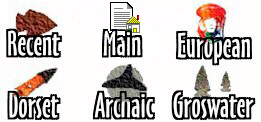
Recent Indians/European Period
As far as we know, Recent Indians arrived in Newfoundland about 2,000 years ago, from Labrador. For 500 years they shared the island with the Dorset people, even though their economic activities steered them to different areas. Like the Maritime Archaic Indians before them, the Recent Indians tended to exploit both inland and marine resources. The sites they chose were more sheltered than those of the Dorset Paleoeskimo; they were sites from which they could easily launch a boat. Whether the Recent Indians are related to the Maritime Archaic Indians is not known. The Maritime Archaic Indians disappeared from the archaeological record 3,200 years ago, and the Recent Indians appeared on the same scene 2,000 years ago. If they are related, where did the Maritime Archaic Indians spend the intervening 1,200 years?
The Recent Indians were given the name Beothuk by the Europeans after their arrival in the 1500s and 1600s. During this period many changes occured in Beothuk technology, influenced by access to European goods. The use of iron to make tools, is one of the excellent distinguishing characteristics of the contact period between the European and Indian populations.
After the arrival of the Europeans on the island, the Indian (Beothuk) population did not survive long. In 1829, four hundred years after the arrival of the Europeans, Shanawdithit, believed to be the last of the Beothuk, died of tuberculosis in St. John's, Newfoundland. The Beothuks were used to fishing along the coast line during the summer, and traveling to the interior in the fall to spend the winter. Once the Europeans arrived they took over all of the rich resources along the coast, forcing the Beothuk inland. The Beothuk could not survive on the meager resources of the interior. The contact that occurred between the groups often resulted in violence, with lives lost on both sides. European diseases to which the Beothuk had no immunity was another factor that contributed to their extinction.
The Spence Site, 1400-800 B.P.
The Spence Site is located across the road from the Sea Echo Motel, in Port au Choix, Newfoundland, and was discovered in 1992. It was occupied for 600 years by the Recent Indians. The primary function of the Spence Site appears to have been a tool-making workshop, where rather coarse-grained local chert was heat-treated to improve its chipping qualities, and then made into tools for use elsewhere. There were twice as many cores and core fragments as finished tools, suggesting that tool-manufacture was the main activity carried out.
